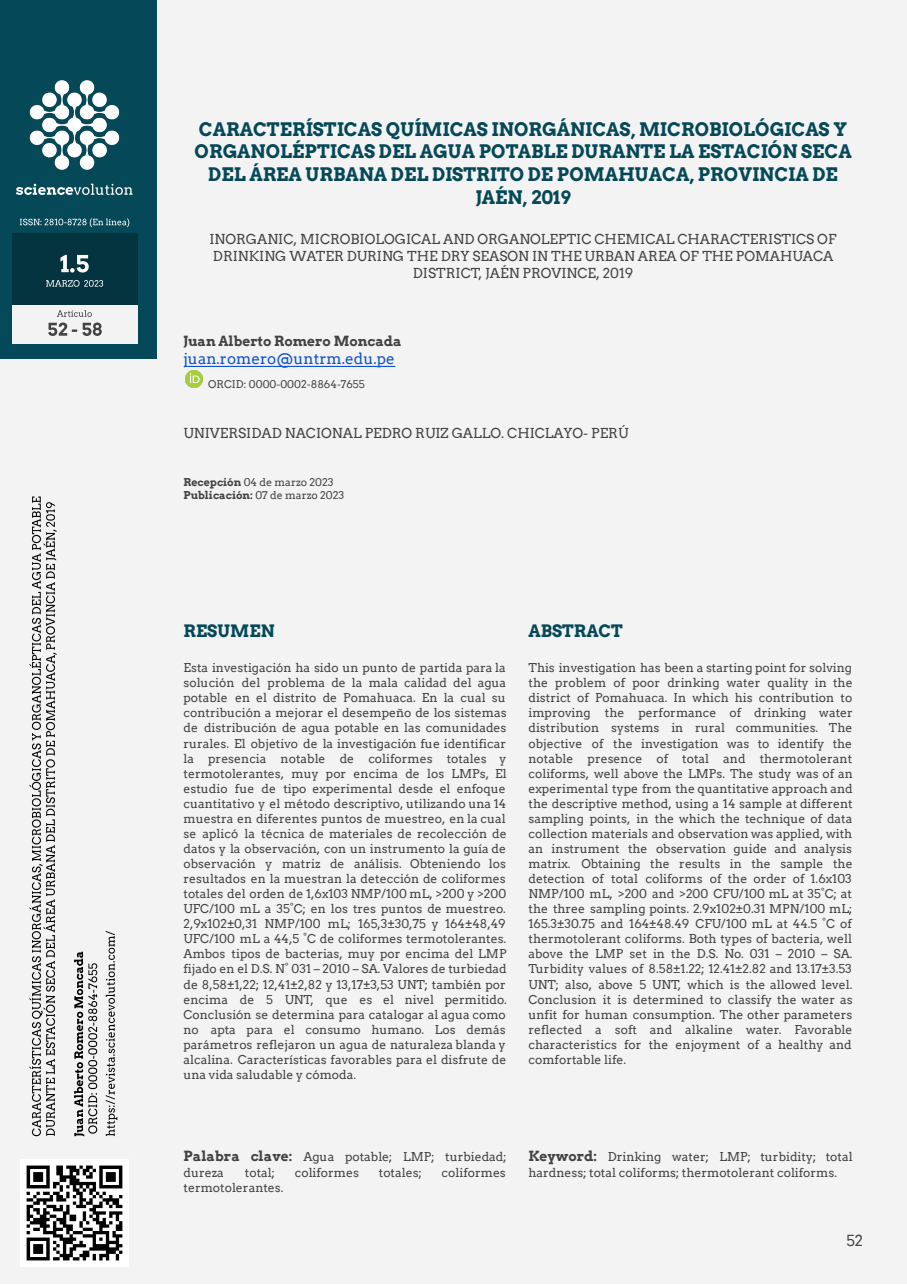Abstract
This investigation has been a starting point for solving the problem of poor drinking water quality in the district of Pomahuaca. In which his contribution to improving the performance of drinking water distribution systems in rural communities. The objective of the investigation was to identify the notable presence of total and thermotolerant coliforms, well above the LMPs. The study was of an experimental type from the quantitative approach and the descriptive method, using a 14 sample at different sampling points, in the which the technique of data collection materials and observation was applied, with an instrument the observation guide and analysis matrix. Obtaining the results in the sample the detection of total coliforms of the order of 1.6x103 NMP/100 mL, >200 and >200 CFU/100 mL at 35°C; at the three sampling points. 2.9x102±0.31 MPN/100 mL; 165.3±30.75 and 164±48.49 CFU/100 mL at 44.5 °C of thermotolerant coliforms. Both types of bacteria, well above the LMP set in the D.S. No. 031 – 2010 – SA. Turbidity values of 8.58±1.22; 12.41±2.82 and 13.17±3.53 UNT; also, above 5 UNT, which is the allowed level. Conclusion it is determined to classify the water as unfit for human consumption. The other parameters reflected a soft and alkaline water. Favorable characteristics for the enjoyment of a healthy and comfortable life.
References
M. Rodriguez-Alvarez, L. Mora, M. Salussoa y L. Seghezzob, “Caracterización espacial y estacional del agua de consumo proveniente de diversas fuentes en una localidad periurbana de Salta”, Revista Argentina de Microbiología, vol. IL, no. 4, pp. 366-376, 2017. [En línea]. Disponible en: https://www.sciencedirect.com/science/article/pii/S0325754117300597
A. E. Medina Chávez, “Calidad del agua en función de turbidez y coliformes en la planta de tratamiento La Quesera, Sucre, Celendín, 2016-2017”, Tesis doctoral, Universidad Nacional de Cajamarca, Perú, 2018. p. 97. Disponible en https://repositorio.unc.edu.pe/handle/UNC/2117
J. A. Villena Chávez, “Calidad del agua y desarrollo sostenible”, Revista Peruana de Medicina Experimental y Salud Pública, vol. 35, no. 2, p. 307-308, 2018. doi:https://doi.org/10.17843/rpmesp.2018.352.3719
Ministerio de Salud – Perú, Reglamento de la calidad del agua para consumo humano: D.S. N° 031-2010-SA. Lima: JB Grafic EIRL. 2011. pp. 1-44.
Organización Mundial de la Salud, Guías para la calidad del agua de consumo humano: cuarta edición que incorpora la primera adenda. 4ª ed. Ginebra. 2018. pp. 139-518. Disponible en https://apps.who.int/iris/handle/10665/272403
Ministerio de Salud – Perú. (2015, Septiembre, 24). Resolución Directoral N° 160 2015/DIGESA/SA, Protocolo de procedimientos para la toma de muestras, preservación, conservación, transporte, almacenamiento y recepción de agua para consumo humano. [En línea]. Disponible en http://www.digesa.minsa.gob.pe/NormasLegales/Normas/RD_160_2015_DIGESA.pdf
Plan Estratégico Concertado de Desarrollo Distrito de Pomahuaca 2004 – 2014 (2017). [Internet]. Disponible en https://docplayer.es/37704786-Equipo-de-trabajo-del-plan-estrategico-concertado-de-desarrollo-distrito-de-pomahuaca.html
C. Severiche, M. Castillo y R. Acevedo, Manual de Métodos Analíticos para la Determinación de Parámetros Fisicoquímicos Básicos en Aguas. Colombia: Fundación Universitaria Andaluza Inca Garcilaso, 2013. pp. 14-17. [En línea]. Disponible en https://www.eumed.net/libros-gratis/2013a/1326/1326.pdf
Superintendencia de Servicios Sanitarios, Manual de métodos de ensayo para agua potable. 2ª ed. Chile. 2007. pp. 20-33.
C. Martinez, (2019). “Investigación Descriptiva: Tipos y Características”. [Internet]. Disponible en https://www.lifeder.com/investigacion-descriptiva/
D. Yanez, (2019). “Método descriptivo: características, etapas y ejemplos”. [Internet]. Disponible en https://www.lifeder.com/metodo-descriptivo/
Ministerio del Ambiente – Perú. (2020, Mar. 15). Decreto Supremo N° 004-2017-MINAM
- Aprueban Estándares de Calidad Ambiental (ECA) para Agua y establecen Disposiciones Complementarias. [En línea]. Disponible en https://www.minam.gob.pe/disposiciones/decreto-supremo-n-004-2017-minam/
Michigan American Water (2020). [Internet]. Disponible en: https://es.amwater.com/miaw/Water-Quality/cross-connection-backflow-prevention
Mapa de importancia hídrica (2013). [Internet]. Disponible en https://zeeot.regioncajamarca.gob.pe/sites/default/files/M20_2_Importancia_hidrica.pdf
Vista satelital de Pomahuaca (s.f.). [Internet]. Disponible en https://satellites.pro/mapa_de_Pomahuaca#-5.933404,-79.227616,17
Agencia Suiza para el Desarrollo y la Cooperación – cosude, Compendio de innovaciones tecnológicas en agua y saneamiento rural – Experiencias del proyecto SABA Plus. Lima: Sinco Industria Gráfica EIRL. 2018. pp. 42-55. Disponible en https://www.cooperacionsuiza.pe/wp-content/uploads/2019/06/2compendio_innovc_tecn_ays_rural-ilovepdf-compressed.pdf

This work is licensed under a Creative Commons Attribution-NonCommercial-NoDerivatives 4.0 International License.
Copyright (c) 2023 http://revista.sciencevolution.com/

